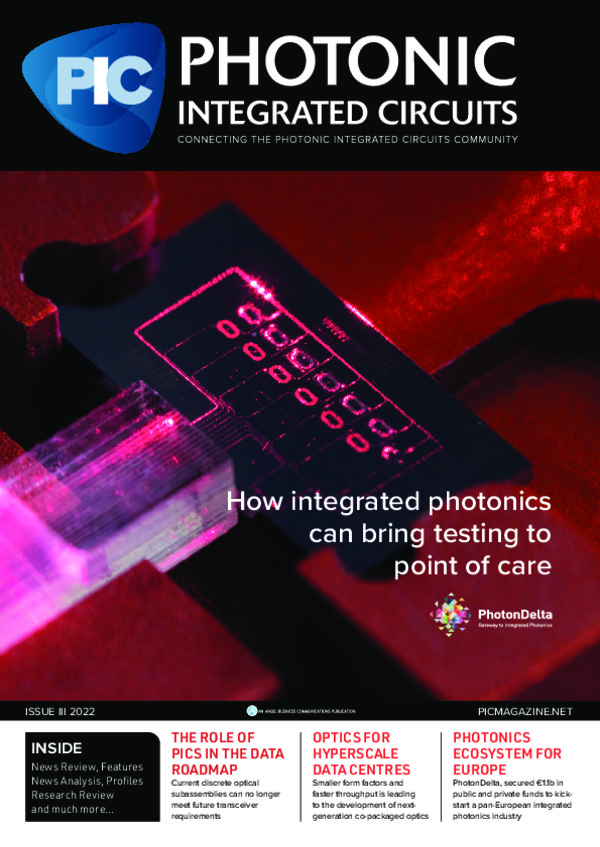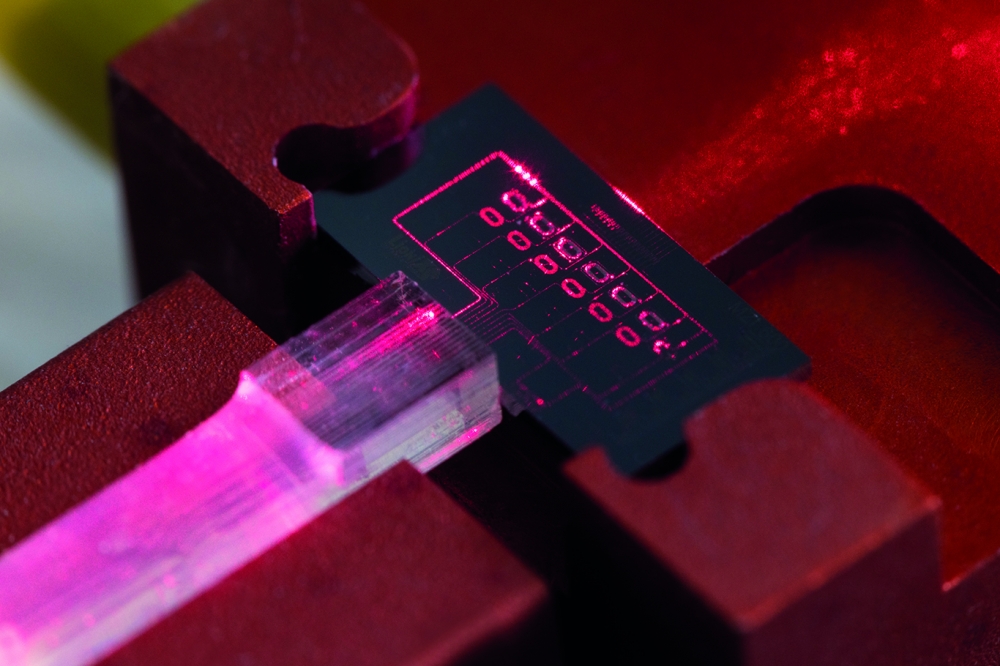
How integrated photonics can bring testing to point of care

The world faces many healthcare challenges. Integrated Photonics is a new chip-like technology that has the promise to revolutionise diagnostics by integrating solutions that are small, scalable and affordable.
BY PHOTONDELTA
Post-pandemic, healthcare providers around the globe face unprecedented challenges in providing timely, affordable, and efficient healthcare in order to improve the quality of care and patient outcomes in both developed and developing countries. With an ageing population, it’s been predicted by RIVM in the Netherlands that in order to keep up with the ever-growing demand for healthcare services, by 2050, 40% of the population will need to work in the sector.
The challenges facing healthcare today
In 2020, the World Health Organization (WHO) published a list of 13 urgent healthcare challenges for the next decade. The rising cost of healthcare in developed countries together with access to healthcare in developing countries are two major challenges to overcome in order to keep pace with global demand and make healthcare fairer.
Discrepancies in healthcare quality not only exist between rich and poor countries, but between different geographical regions within the same country. There are also environmental challenges to consider, such as access to clean water, and raising the profile of health within the context of climate change. This means global leaders need to improve air-quality and tackle climate change in order to reduce their negative impacts on our health.
Extreme weather events caused by climate change also have a direct consequence on our health, and can lead to malnutrition, the spread of infectious diseases, and global pandemics. If we learnt anything from COVID-19, it’s that the world needs fast and effective solutions to halt the spread of viruses. But at the same time, with the global rise in less visible, non-communicable diseases (NCD), such as cancer and diabetes, we’re also seeing an invisible epidemic which the WHO say adds up to 71% of the total annual death rate.
One way to address the gaps in patient outcomes is through more personalized healthcare. Why? It enables better treatment, which then leads to better patient care, but it also requires more effective diagnosis. In addition, preventative healthcare uses anticipatory measures to mitigate health problems before they arise. This includes things like education around healthy lifestyles to address issues such as obesity.
Clearly, something needs to be done now to meet the world’s ever-changing healthcare needs. Action is needed throughout the care cycle, from healthy living and more effective diagnosis, to better patient monitoring during and post treatment. Tackling these challenges requires new approaches to healthcare, including the uptake of innovative and disruptive technologies to prevent, diagnose, and treat different medical conditions.
Image of photonic chips with a biochip in the middle
How integrated photonics can help
At the present time, specialized laboratories and hospitals perform highly specialized and complex testing. This process is not only expensive, it can also create bottlenecks within the healthcare system, causing delays in diagnosis and subsequent treatment. It’s also not accessible to part of the world’s population.
In principle, integrated photonics is able to improve diagnostic support by bringing sensing, imaging, and testing to frontline healthcare workers and their patients. Photonic chips, which are designed and fabricated like semiconductors, can provide small, lightweight, low-powered solutions ranging from fast and low-cost testing and preventative healthcare to patient monitoring and point of care (POC) diagnostics.
The use of integrated photonics enables medical device companies to develop increasingly reliable and sustainable solutions at scale, for a reduced cost, and using less energy.
Image of a near infrared spectral sensor from MantiSpectra that is used for the detection of e.g. illicit drugs
Cutting the cost of healthcare
POC testing could help to cut healthcare costs and save time, by bringing reliable and accurate diagnostic devices to general practitioners (GP). In some cases, diagnostics, which could take 3 to 4 days in a centralized laboratory, could take 20 minutes with a local doctor. Based on the Worldbank’s estimation of more than 9 million GPs worldwide, this is an incredible opportunity for healthcare professionals to deliver better, more timely care to their patients. It could even allow patients to perform certain tests at home. For medical device companies, there is also the appeal of a growing market. Grandview Research puts this value at $36 billion USD in 2021, and that figure is set to double in size by 2028.
For doctors in developing countries, diagnostic tests might take months to complete, so having portable and relatively inexpensive diagnostic tools on the frontline can make a huge difference. Rapid testing currently has high visibility in applications such as glucose monitoring, haematology, pregnancy and fertility testing. At the same time, the recent pandemic has shown people the importance of POC testing, in the form of lateral flow and polymerase chain reaction (PCR) tests.
Integrated photonics opens up the possibility for similar applications in other areas of healthcare. As wearable devices, such as smartwatches, become ever smarter and more popular, they look certain to play a larger role in healthcare, with consumer tech and medtech starting to merge more deeply. Optical technology is already firmly embedded in existing wearable devices, so integrated photonics can play a key role in taking medical functionality and applications to the next level. For device manufacturers, Yole Development estimates that by 2028 the market size for wearables will have grown to over $111 billion USD from just over 21 billion USD in 2021.
Alongside wearable technology, biosensors have an important part to play in the evolution of healthcare. PCR tests are one example of a commonly used biosensor. This technology has the potential to revolutionize healthcare by not only changing the way human health is managed and monitored, but by detecting and diagnosing diseases and microorganisms. Photonic biosensors offer fast, effective, disposable, and one-time-only tests.
Disruptive healthcare technologies
Sharing similarities with the manufacturing of semiconductor devices, integrated photonics enables developers to use tried and tested building blocks to create new and innovative solutions. This means that integrated photonics offers medical device companies the opportunity to develop highly scalable and cost-effective POC testing and bring it to market faster. At the same time, the costs associated with improvements can be dramatically reduced. Here are six important photonic integrated circuit (PIC) platforms and their applications in POC testing:
Visible and near infrared spectroscopy
Used in smartwatches, visible and near infrared spectroscopy (NIRS) can measure vital signs such as heart rate, and biochemical markers including dehydration, and proteins.
In recent years, the exceptional growth of smartwatches and trackers shows the scaling and improvement potential for this type of technology. Initially, offering functionality related to sports and a more healthy lifestyle, wearables are beginning to lean into medical applications as well. By extending multispectral infrared spectroscopy using PICs, it’s possible for wearables to monitor an array of biological information including levels of glucose, alcohol, and protein.
Raman spectroscopy
Well-known in testing laboratories, Raman spectroscopy is currently an expensive and complicated tool for measuring biochemical markers. However, when it comes to detection, Raman spectroscopy is the most accurate and specific solution. It has a variety of applications across multiple areas of medicine, ranging from breath analysis to bacteria typing.
Biochips
Photonic biosensors provide fast and effective rapid testing covering a range of functions from DNA and proteins to pollutants and contaminants. They can also be used to diagnose NCDs. Integrated photonic biochips are an ideal platform for POC testing because they are extremely sensitive detectors, which use ring resonators or Mach-Zehnder interferometer chips. They can detect multiple diseases, infections, or viruses, such as COVID-19, as well illnesses such as cancer using various biomarker layers. Easy to scale, they offer low-cost potential when produced in larger volumes.
Optical Coherence Tomography (OCT)
Currently used across a range of medical areas, including ophthalmology, oncology, and cardiology, Optical Coherence Tomography (OCT) has the potential to improve early detection, particularly in hard-to-diagnose illnesses such as bladder cancer.
Commonly found in large laboratory instruments with discrete optical components, OCT integrations also enable developers to create smaller, low-cost instruments for new applications. Two existing approaches are in use and highly suited for PICs: Spectral Domain uses a broadband light source and a spectrometer; Swept Source uses a tuneable laser.
Optoacoustic, photoacoustic, and fully optical ultrasound
Already used for a number of medical applications, these platforms essentially put a laser beam through soft tissue. As the laser hits the tissue in short pulses, it creates thermal expansion and relaxation, which can be measured as ultrasound waves. This optical sound can be detected and used to create an image of the soft tissue. Using integrated photonic microphones enables very sensitive ultrasound arrays. With broad applications in soft tissue imagining, such as proton therapy, in certain circumstances it could even replace MRI scanners.
Fibre Bragg grating sensing
This special type of fibre, which uses light to detect vital signs, has applications in all kinds of patient monitoring such as temperature, pressure, strain, and vibration. The specially prepared fibre is non-conductive and immune to electric and magnetic fields (MRI sensing). Detecting the wavelength shift of reflected light under temperature or pressure change, it is extremely accurate. Applications can be found in catheters (haptic feedback), patient monitoring, and shape sensing. It can also be used in diagnostic and interventional cardiology to detect heart failure.
Image of a biochip from Surfix Diagnostics, produced by LioniX International
Future opportunities
Without question, integrated photonics has the potential to revolutionize the healthcare industry by helping it to overcome some of the toughest, global challenges. As a technology, integrated photonics, provides the opportunity for volume scaling, miniaturization, and low-cost manufacturing of POC medical devices which provide faster diagnostics, and preventive insights.
As we’ve seen, six diagnostic platforms have the potential to serve multiple applications, and each time a new tried and tested ‘building block’ is added, it enables developers to iterate faster – ultimately, reducing the time to market for new medical devices. Soon, devices small enough to sit on the desk of a GP will become commonplace, as testing moves ever closer to the point of care, with the help of integrated photonics.
These accurate smaller, and more accessible devices will provide long term value for money, and being to empower GP’s, with the kind of diagnostic capabilities previously only available to expensive laboratories or specialist hospital departments. Frontline diagnostics, whether in a hospital or out in the field, can then enable medical practitioners to quickly escalate patients who need expert care, and drastically reduce the patient timeline from diagnosis through to recovery.
Innovative medical device companies, leveraging the potential of integrated photonics, need a full value chain, including supporting analysis software and tools. PhotonDelta is a ready-made and steadily growing public-private partnership providing an end-to-end supply chain and a community of innovative enterprises and manufacturers of photonics technology.
The PhotonDelta growth fund supports platform and value chain developments within the integrated photonics industry. Find out more by downloading PhotonDelta’s roadmap for Integrated Photonics for Biosensing 2021.
Image of a biochip from Delta Diagnostics, produced by LioniX International



































